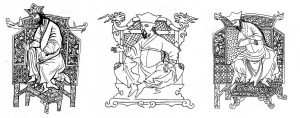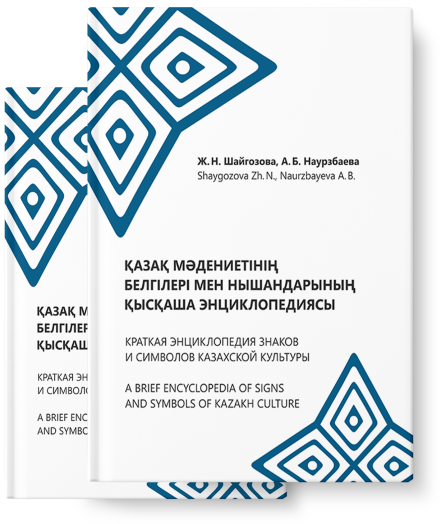
A short encyclopedia of
Signs and symbols of
Kazakh culture

One of the variants of the ritual of enthronement of khans best illuminated in the written sources of the pre-revolutionary period is the ritual “Khan koturmak” with the use of white koshma (in a semiotic interpretation studied by A.A. Galiev). Recently, however, scholars have argued that there is a ritual in which the throne and crown are used to become khan. In this regard, N. Atygayev, citing folk and written sources, writes: …throne and crown were used in the Kazakh khanate as symbols of supreme authority and statehood.By their origin they were connected with the attributes of the Mongol state power [5, p.8]. A.S. Bimendiyev, in turn, believes that the ritual of elevation of Kazakh khans consisted of two stages: “First, the claimant was raised on felt (“ascent” to heaven), then lifted on a stone slab -the throne”. And: “The etymology of the stone throne (taht=tag) goes back to the ancient Tengrian representations of the Turks about the holy mountain” [6, p.75].
In some sources, the emphasis in describing the throne is placed on the material (pure gold) and on the elements that adorn it (at the four corners there are figures of lion, leopard, tiger and dragon). In its symbolic and sacral meaning, the material of the throne – gold – is the oldest color symbol of the tsars. The presence of real and mythical animals has a symbolic meaning: lion, leopard and tiger – eternal symbols of bravery, courage and heroism, and the dragon – one of the oldest totemic cults of the peoples of Eurasia (according to some scholars, the dragon and the wolf are symbolically identical, and on the other hand – the dragon was represented as the primacy of the universe).Their “sitting” on the four corners of the throne (four sides of the world) embodies the motives of inviolability of power, of the state. Describing the later Kazakh throne, T.I. Sultanov notes that it was not a richly decorated wooden chair, but a cushion mounted on the hill, covered with richly embroidered gold and decorated with precious stones [10, p.65]. This throw A.S. Bimendiev calls “canopy”. And this version of the throne seat contains gold and precious stones as symbolic attributes emphasizing the special status of the ruler.
In the past, the sacral attributes of the supreme power of the Kazakhs were the throne, the crown, the signet ring, the khan-tamga, and, of course, the clothing characteristic of the members of the sultanate. All attributes (in combination with various means – color, material, actions, etc.) emphasized the main idea – the idea of divinity of the ruler – the status of a key figure – the khan, who was endowed with almost supernatural power in the understanding of society. The ritual of the khan’s enthronement bore the traces of the traditions of the early analogs that existed among the Eurasian nomads.

